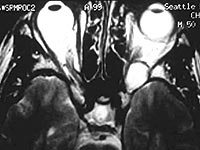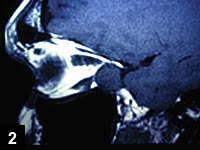Endoscopic surgery for orbital apex tumors reduces risk and speeds recovery
Three-dimensional intraoperative imaging assists surgeons in avoiding vital intraorbital and intracranial structures.
Click Here to Manage Email Alerts
An endoscopic technique for removing orbital apex tumors through the nose is safer and more cost-effective than traditional orbitotomy or craniotomy, according to two surgeons who developed it.
 Chester F. Griffiths |  Howard R. Krauss |
Transnasal, image-guided endoscopic orbital apex surgery reduces risks to vital intraorbital and intracranial structures, Chester F. Griffiths, MD, FACS, and Howard R. Krauss, MD, told Ocular Surgery News in a telephone interview.
Dr. Griffiths, a head and neck surgeon, and Dr. Krauss, a surgical neuro-ophthalmologist, pioneered the technique in 2001 and have continued to apply it routinely.
“The main advantage is the direct access to the tumor,” Dr. Griffiths said. “We can remove the tumor without going through other vital structures.”
Transnasal orbital apex surgery is part of a growing trend toward minimally invasive techniques, particularly in neurosurgery, Dr. Krauss said.
“You should view this in light of a general trend of surgery to do things that are less invasive and to do things endoscopically,” he said.
 |
 |
|
| Non-contrast axial orbital MRI of a 50-year-old man with progressive vision loss in the left eye and a left relative afferent pupil defect, revealing a left orbital apex mass. T1 is isointense with brain and T2 is bright, consistent with cavernous hemangioma. | ||
 |
 |
|
| Sagittal views reveal far posterior location of mass, inferior to optic nerve. | ||
 |
 |
|
| Left orbital apex mass in a 47-year-old woman with progressive optic neuropathy — bright on coronal T2 and enhancing on axial T1 fat saturation with gadolinium, consistent with cavernous hemangioma. | ||
 |
||
| Surgery is initiated with endoscopic visualization of landmarks with real-time verification by multiplanar cross-haired localization on the computer display of the patient’s own stored CT imaging. |
Transnasal orbital apex surgery is performed on an outpatient basis, which cuts costs, Dr. Griffiths said, noting significantly lower morbidity and more rapid recovery compared with other approaches.
Orbital apex tumors are often benign and generally present with visual loss resulting from optic nerve compression, he said.
Navigation and dissection
Traditional orbital apex surgery techniques include extended lateral orbitotomy, medial transconjunctival/transcaruncular orbitotomy and frontotemporal craniotomy, Dr. Griffiths said.
“Those approaches are all fine, but they carry greater risk of injury to other structures, and the morbidity of these approaches usually calls for hospitalization and prolonged healing times,” he said.
Three-dimensional intraoperative imaging enables surgeons to operate with lower risk of damage to important structures than conventional techniques, Dr. Griffiths said.
“Basically, this is an intraoperative verification of anatomic localization, so that we can verify where our safe limits are in three dimensions before we actually make an incision,” he said.
A team approach
Transnasal orbital apex surgery has evolved via collaboration between a head and neck surgeon and a neurosurgical ophthalmologist. It requires four hands: one to hold the video scope, one to displace orbital tissues with a right-angled instrument, one to grip the tumor and one to dissect tumor attachments, Dr. Griffiths and Dr. Krauss said during their presentation in September at the combined meeting of the World Federation of Skull Base Surgery and the North American Skull Base Society in Vancouver, British Columbia.
To date, surgical time has ranged from 90 minutes to 4 hours. Surgical time depends on pathology, Dr. Griffiths said.
Ophthalmologists have traditionally avoided intranasal procedures but are growing more comfortable with transnasal lacrimal and orbital surgery.
“Just like any new technique, it will be a matter of people becoming familiar with it and learning how to do it,” he said. — by Matt Hasson

- Chester F. Griffiths, MD, FACS, and Howard R. Krauss, MD, can be reached at Pacific Eye and Ear Specialists, 11645 Wilshire Blvd., 8th floor, Los Angeles, CA 900025; 310-477-5558; e-mail: drchester@pacificspecialists.com, drkrauss@pacificspecialists.com.
